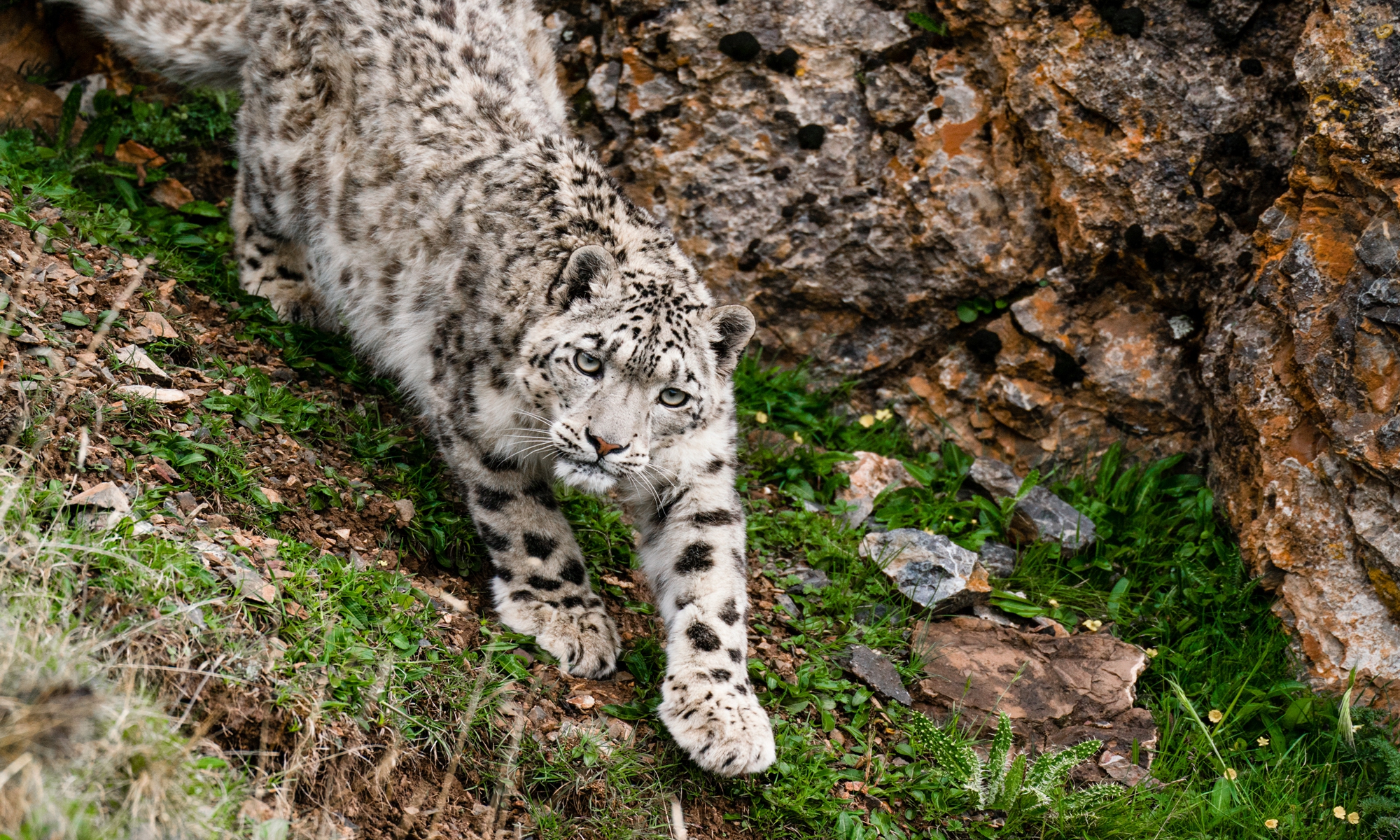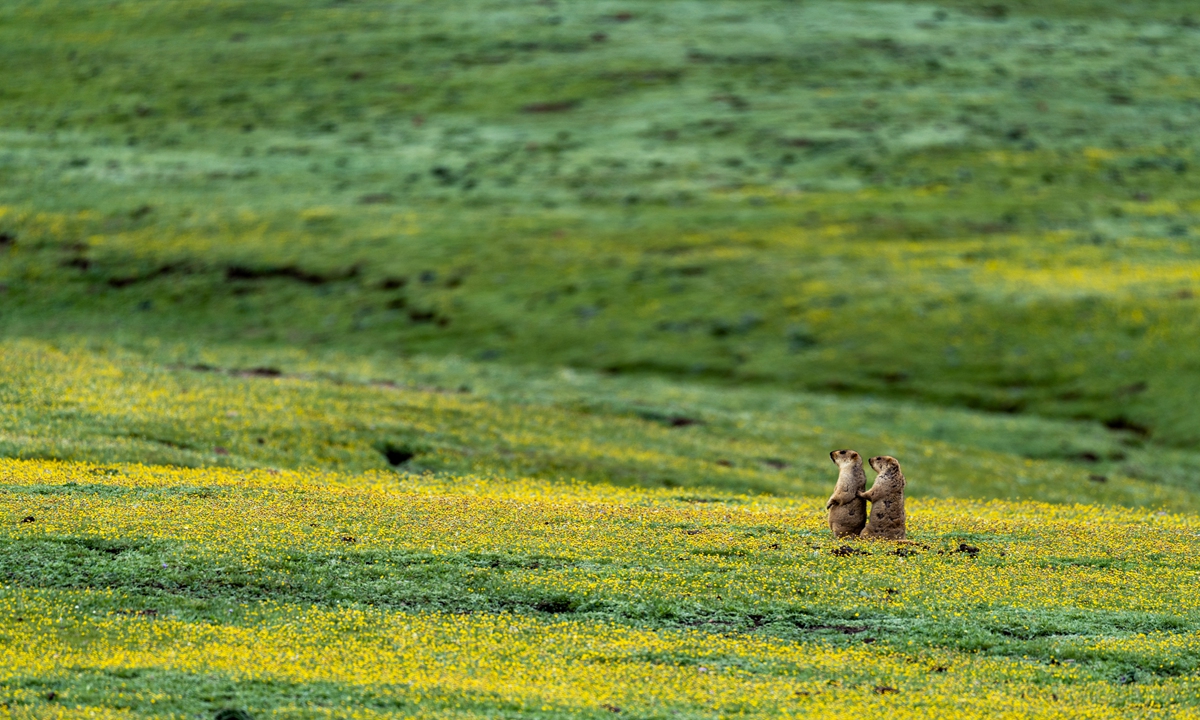
A snow leopard descends from among the rocks in the Sanjiangyuan region. Photo: Courtesy of Xi Zhinong
For most people who have paid attention to wildlife photography in China, the name "Xi Zhinong" is probably familiar. This year marks the 40th year of Xi Zhinong's wildlife photography career which started when he first got an opportunity working as an assistant in a field photography group in 1983.
As one of the top wildlife photographers in China, Xi enjoys an excellent reputation in Chinese photography and environmental conservation circles for the contributions he has made to China's wildlife photography and protection fields.
Aside from his personal career, over the last two decades, Xi has also been recruiting more nature photographers from among the ranks of Tibetan herdsmen and frontline workers at nature reserves, offering them training. Among Xi's trainees, a few outstanding photographers were featured in a recent documentary
Snow Leopards and Friends, which will be released on August, 2023.
Call of dutyLocated in Deqin county, Southwest China's Yunnan Province, the Baima Snow Mountain is the last known home of the endangered Yunnan snub-nosed monkey. In 1995, when the local government announced its plan to cut down 100 square kilometers of the primeval forest on the south side of the Baima Snow Mountain Nature Reserve, Xi took action.
He recorded the Yunnan snub-nosed monkeys living in the Baima Snow Mountain through videos, showcasing their lives in the wild to the public for the first time, and effectively protected the primeval forest and habitat of the snub-nosed monkeys.
Among these images and video recordings of the Yunnan snub-nosed monkeys, the most widely-known is his iconic photograph "Mother and Child." Since then, his work has been featured widely in international media outlets such as Newsweek, Time Magazine, BBC Wildlife, and National Geographic.
In 1997, he went deep into Hoh Xil region in Northwest China's Qinghai Province, to reveal the large-scale poaching of Tibetan antelopes and report on the heroic deeds of a team called the Wild Yak Team fighting poachers to protect Tibetan antelopes. In the process, he became the first photographer to capture images of the Grey-headed Parrotbill, a type of small bird that lives only in the Songpan region, the border areas of Northwest China's Qinghai Province, Gansu Province, and Southwest China's Sichuan Province.
Xi employs visual storytelling to document and preserve a multitude of endangered species in China. His remarkable achievements have garnered him many photography and filmmaking awards, both domestically and internationally, including the Gerald Durrell Award for Endangered Wildlife at the Wildlife Photographer of the Year in 2001, which made him the first Chinese recipient of this prestigious award. His achievements also paved the way for him to be the first Chinese photographer to be inducted into the International League of Conservation Photographers.
In 2002, Xi founded Wild China Film, with a mission to "use the power of images to protect Nature." The agency focuses on recording endangered species and changes in the Chinese natural environment, raising awareness of nature conservation among the government and public.
"I have always thought that it's a pity that most Chinese people do not know enough about China's native wildlife species and natural environment," Xi said.
In the early 1980s, CCTV launched the program "Animal World." Since then, the Chinese public has had access to the best nature and wild animal documentaries in the world through this program, but all they can see were animals outside China, he noted.
"Most Chinese know how wildebeest herds migrate and how cheetahs catch antelopes in the African wilderness; how Antarctic emperor penguins feed their offspring in the depths of the Antarctic continent, and how polar bears catch seals, but they don't know that in China there are several kinds of gibbons, and that Tibetan antelopes also migrate every year on the Qinghai-Tibet Plateau. They don't seem to know much about other animals in China except for giant pandas," Xi noted as he explained his reason for his focus on native Chinese wildlife to the Global Times.

A pair of Himalayan marmots in the Sanjiangyuan region Photo: Courtesy of Wild China
Record together
Since 2004, Xi has organized many wildlife photography training camps through his organization Wild China Film to provide professional training for frontline workers at national reserves, to help them better record wildlife in the line of duty.
In 2016, Xi became acquainted with several herders in Zadoi county, Qinghai Province, who were greatly interested in wildlife photography. At the time, the herders had saved a snow leopard that had sustained an injury from hunting and planned to release it back into the wild after it had recovered. Xi was contacted by the county's local official to witness the release process.
Xi was moved by these herders' passion in photography, while at the same time, looking at their digital zoom card machine which was not ideal for wildlife photography, he felt he needed to do something for them.
"If I give them better equipment and teach them professional photography techniques, they will definitely be able to produce better images. Their ancestors have lived in that place for generations. They are familiar with the mountains and rivers of that place. Their eyes are much keener and they climb mountains rapidly," Xi said. "Most importantly, these herders' respect for life and affection for nature goes beyond the imagination of many people."
In that year, Xi launched the wildlife photographer training program for herders. Dajie, Ciding, and Kunchochopeng were among the first to sign on.
Xi recalled that in July 15, 2019, it snowed a lot. They eagerly anticipated a white leopard sighting. When Xi and his team members reached the hidden station tent at an altitude of 500 meters above sea level, Ciding noticed a small bug which had landed on the snow above the tent. He picked it up with his hands and gently put it on the ground before shaking the snow off the tent.
"What I saw was that their respect for life was innate and I was deeply moved," Xi said.
The scale of the herder photographer group has expanded greatly. There are now more than 40 photographers. "Photography has become a fashion pursued by local young herders," he said.
In the past, herdsmen would buy motorcycles after digging up Chinese caterpillar fungus and selling them, but now many of them use the money to buy photography equipment. In 2020, these herder photographers even held an exhibition in Shanghai.
When asked about his future plans, Xi told the Global Times, "From the day I picked up the camera, all I wanted to do was to become a wildlife photographer, capturing the animal world in China. In fact, I have been working for most of my life to achieve this goal."
"I will continue go on and on down this road, without a doubt."





